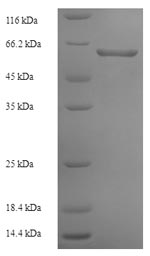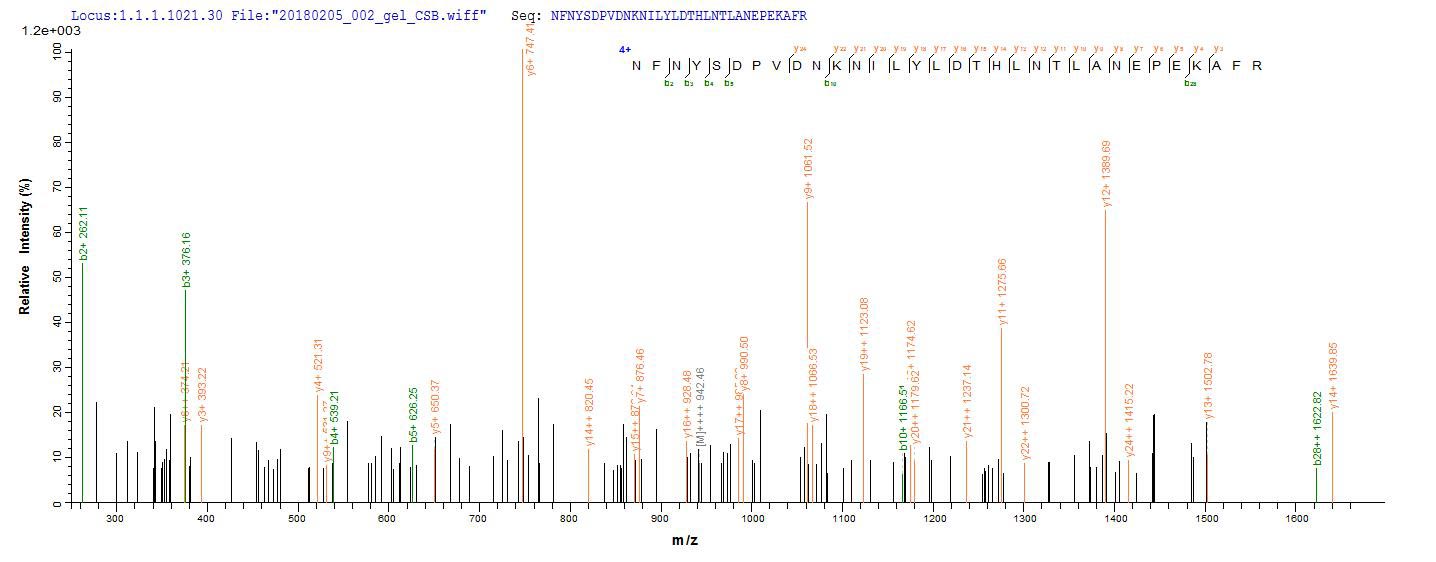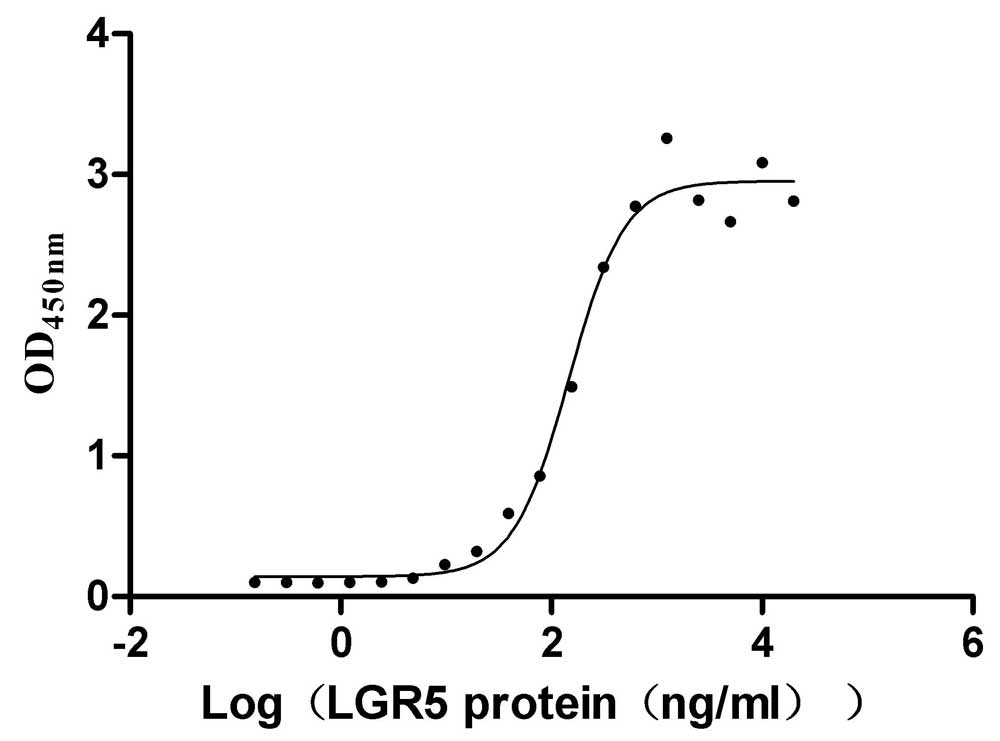Recombinant Clostridium botulinum C phage Botulinum neurotoxin type C, partial
In Stock-
中文名称:Recombinant Clostridium botulinum C phage Botulinum neurotoxin type C,partial
-
货号:CSB-EP325596CLQ
-
规格:¥2328
-
图片:
-
(Tris-Glycine gel) Discontinuous SDS-PAGE (reduced) with 5% enrichment gel and 15% separation gel.
-
Based on the SEQUEST from database of E.coli host and target protein, the LC-MS/MS Analysis result of CSB-EP325596CLQ could indicate that this peptide derived from E.coli-expressed Clostridium botulinum N/A.
-
Based on the SEQUEST from database of E.coli host and target protein, the LC-MS/MS Analysis result of CSB-EP325596CLQ could indicate that this peptide derived from E.coli-expressed Clostridium botulinum N/A.
-
-
其他:
产品详情
-
纯度:Greater than 90% as determined by SDS-PAGE.
-
基因名:N/A
-
Uniprot No.:
-
别名:Botulinum neurotoxin type C; BoNT/C; Bontoxilysin-C1; BoNT/C1; Botulinum neurotoxin type C1) [Cleaved into: Botulinum neurotoxin C light chain; LC; EC 3.4.24.69); Botulinum neurotoxin C heavy chain; HC)]
-
种属:Clostridium botulinum C phage (Clostridium botulinum C bacteriophage)
-
蛋白长度:Partial
-
来源:E.coli
-
分子量:64.9kDa
-
表达区域:2-428aa
-
氨基酸序列PITINNFNYSDPVDNKNILYLDTHLNTLANEPEKAFRITGNIWVIPDRFSRNSNPNLNKPPRVTSPKSGYYDPNYLSTDSDKDPFLKEIIKLFKRINSREIGEELIYRLSTDIPFPGNNNTPINTFDFDVDFNSVDVKTRQGNNWVKTGSINPSVIITGPRENIIDPETSTFKLTNNTFAAQEGFGALSIISISPRFMLTYSNATNDVGEGRFSKSEFCMDPILILMHELNHAMHNLYGIAIPNDQTISSVTSNIFYSQYNVKLEYAEIYAFGGPTIDLIPKSARKYFEEKALDYYRSIAKRLNSITTANPSSFNKYIGEYKQKLIRKYRFVVESSGEVTVNRNKFVELYNELTQIFTEFNYAKIYNVQNRKIYLSNVYTPVTANILDDNVYDIQNGFNIPKSNLNVLFMGQNLSRNPALRKVNPEN
Note: The complete sequence including tag sequence, target protein sequence and linker sequence could be provided upon request. -
蛋白标签:N-terminal 6xHis-SUMO-tagged
-
产品提供形式:Liquid or Lyophilized powder
Note: We will preferentially ship the format that we have in stock, however, if you have any special requirement for the format, please remark your requirement when placing the order, we will prepare according to your demand. -
缓冲液:Tris-based buffer,50% glycerol
-
储存条件:Store at -20°C/-80°C upon receipt, aliquoting is necessary for mutiple use. Avoid repeated freeze-thaw cycles.
-
保质期:The shelf life is related to many factors, storage state, buffer ingredients, storage temperature and the stability of the protein itself.
Generally, the shelf life of liquid form is 6 months at -20°C/-80°C. The shelf life of lyophilized form is 12 months at -20°C/-80°C. -
货期:3-7 business days
-
注意事项:Repeated freezing and thawing is not recommended. Store working aliquots at 4°C for up to one week.
-
Datasheet & COA:Please contact us to get it.
相关产品
靶点详情
-
功能:Botulinum toxin causes flaccid paralysis by inhibiting neurotransmitter (acetylcholine) release from the presynaptic membranes of nerve terminals of the eukaryotic host skeletal and autonomic nervous system, with frequent heart or respiratory failure. Is unique among characterized BoNTs in having 2 substrates, syntaxin (STX) and SNAP25. Precursor of botulinum neurotoxin C which unlike most BoNTs seems not to have a proteinaceous coreceptor, and instead recognizes 2 different complex polysialylated gangliosides found on neural tissue probably found in synaptic vesicles. Upon synaptic vesicle recycling the toxin is taken up via the endocytic pathway. When the pH of the toxin-containing endosome drops a structural rearrangement occurs so that the N-terminus of the heavy chain (HC) forms pores that allows the light chain (LC) to translocate into the cytosol. Once in the cytosol the disulfide bond linking the 2 subunits is reduced and LC cleaves its target protein on synaptic vesicles, preventing their fusion with the cytoplasmic membrane and thus neurotransmitter release. In vitro the whole toxin only has protease activity after reduction. Electrical stimulation increases uptake of toxin, presumably by transiently exposing a receptor usually found in eukaryotic target synaptic vesicles. Forms ion-conducting channels at around pH 6.1. Requires complex eukaryotic host polysialogangliosides for full neurotoxicity. Synaptic vesicle glycoproteins (SV2) do not seem to act as its receptor.; Has proteolytic activity. After translocation into the eukaryotic host cytosol, inhibits neurotransmitter release by acting as a zinc endopeptidase that cleaves syntaxin-1A/STX1A and syntaxin-1B/STX1B. Cleaves the '253-Arg-|-Ala-254' bond of STX1 and the '252-Arg-|-Ala-253' bond of STX2; also acts on syntaxin 3 (STX3) but not 4 (STX4). Cleaves the '198-Arg-|-Ala-199' bond of SNAP25. Recognizes the '93-Asn--Met-202' region of SNAP25.; Responsible for host epithelial cell transcytosis, host nerve cell targeting and translocation of light chain (LC) into eukaryotic host cytosol. Composed of 3 subdomains; the translocation domain (TD), and N-terminus and C-terminus of the receptor-binding domain (RBD). The RBD is responsible for the adherence of the toxin to the eukaryotic target cell surface. It simultaneously recognizes 2 polysialated gangliosides coreceptors in close proximity on host synaptic vesicles. The N-terminus of the TD wraps an extended belt around the perimeter of the LC, protecting Zn(2+) in the active site; it may also prevent premature LC dissociation from the translocation channel and protect toxin prior to translocation. The TD inserts into synaptic vesicle membrane to allow translocation into the host cytosol. The C-terminal half of the HC (residues 864-1291) binds neurons in a dose-dependent manner. The C-terminal half of the HC (residues 863-1291) binds eukaryotic host gangliosides in the order GD1b > GT1b > GD1a > GM1a. Has 2 ganglioside binding sites; Sia-1 prefers a sia7 sialic acid and sugars within the ganglioside (GD1b > GT1b), whereas GBP2 recognizes a sia5 sialic acid (GT1b and GD1a). Both sites are required for HC to enter neurons, acting via different gangliosides. This suggests that 2 gangliosides serve as toxin receptors. Synaptic activity (depolarization with K(+)) increases uptake by neurons. Treatment of synaptosomes with proteinase K does not reduce HC binding, suggesting there is no protein receptor or it is protected from extracellular proteases. Decreases uptake and toxicity of whole BoNT/A, but also interferes with uptake of BoNT/E and BoNT/F. HC also binds phosphoinositides, which might play a role in membrane-binding.
-
亚细胞定位:[Botulinum neurotoxin type C]: Secreted.; [Botulinum neurotoxin C light chain]: Secreted.; [Botulinum neurotoxin C heavy chain]: Secreted.
-
蛋白家族:Peptidase M27 family
Most popular with customers
-
Recombinant Macaca mulatta Microtubule-associated protein tau (MAPT) (Active)
Express system: Mammalian cell
Species: Macaca mulatta (Rhesus macaque)
-
Recombinant Human R-spondin-1 (RSPO1), partial (Active)
Express system: Mammalian cell
Species: Homo sapiens (Human)
-
Express system: Mammalian cell
Species: Macaca fascicularis (Crab-eating macaque) (Cynomolgus monkey)
-
Recombinant Macaca fascicularis Claudin (CLDN18)-VLPs (Active)
Express system: Mammalian cell
Species: Macaca fascicularis (Crab-eating macaque) (Cynomolgus monkey)
-
Recombinant Human Microtubule-associated protein tau (MAPT) (Active)
Express system: Mammalian cell
Species: Homo sapiens (Human)
-
Recombinant Human Tumor-associated calcium signal transducer 2 (TACSTD2), partial (Active)
Express system: Mammalian cell
Species: Homo sapiens (Human)
-
Recombinant Human Cell adhesion molecule 1 (CADM1), partial (Active)
Express system: Mammalian cell
Species: Homo sapiens (Human)
-
Recombinant Human Cadherin-17 (CDH17), partial (Active)
Express system: Mammalian cell
Species: Homo sapiens (Human)









-AC1.jpg)













